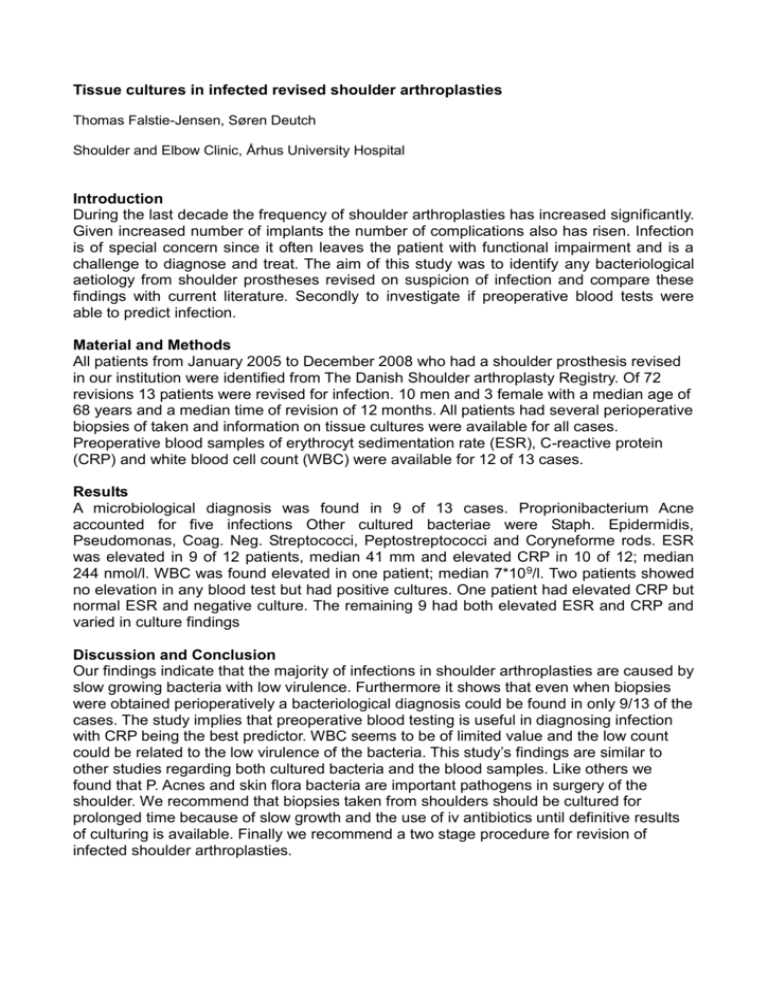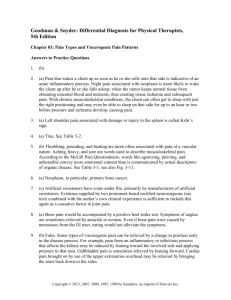Tissue cultures in infected revised shoulder arthroplasties
advertisement

Tissue cultures in infected revised shoulder arthroplasties Thomas Falstie-Jensen, Søren Deutch Shoulder and Elbow Clinic, Århus University Hospital Introduction During the last decade the frequency of shoulder arthroplasties has increased significantly. Given increased number of implants the number of complications also has risen. Infection is of special concern since it often leaves the patient with functional impairment and is a challenge to diagnose and treat. The aim of this study was to identify any bacteriological aetiology from shoulder prostheses revised on suspicion of infection and compare these findings with current literature. Secondly to investigate if preoperative blood tests were able to predict infection. Material and Methods All patients from January 2005 to December 2008 who had a shoulder prosthesis revised in our institution were identified from The Danish Shoulder arthroplasty Registry. Of 72 revisions 13 patients were revised for infection. 10 men and 3 female with a median age of 68 years and a median time of revision of 12 months. All patients had several perioperative biopsies of taken and information on tissue cultures were available for all cases. Preoperative blood samples of erythrocyt sedimentation rate (ESR), C-reactive protein (CRP) and white blood cell count (WBC) were available for 12 of 13 cases. Results A microbiological diagnosis was found in 9 of 13 cases. Proprionibacterium Acne accounted for five infections Other cultured bacteriae were Staph. Epidermidis, Pseudomonas, Coag. Neg. Streptococci, Peptostreptococci and Coryneforme rods. ESR was elevated in 9 of 12 patients, median 41 mm and elevated CRP in 10 of 12; median 244 nmol/l. WBC was found elevated in one patient; median 7*10 9/l. Two patients showed no elevation in any blood test but had positive cultures. One patient had elevated CRP but normal ESR and negative culture. The remaining 9 had both elevated ESR and CRP and varied in culture findings Discussion and Conclusion Our findings indicate that the majority of infections in shoulder arthroplasties are caused by slow growing bacteria with low virulence. Furthermore it shows that even when biopsies were obtained perioperatively a bacteriological diagnosis could be found in only 9/13 of the cases. The study implies that preoperative blood testing is useful in diagnosing infection with CRP being the best predictor. WBC seems to be of limited value and the low count could be related to the low virulence of the bacteria. This study’s findings are similar to other studies regarding both cultured bacteria and the blood samples. Like others we found that P. Acnes and skin flora bacteria are important pathogens in surgery of the shoulder. We recommend that biopsies taken from shoulders should be cultured for prolonged time because of slow growth and the use of iv antibiotics until definitive results of culturing is available. Finally we recommend a two stage procedure for revision of infected shoulder arthroplasties.






